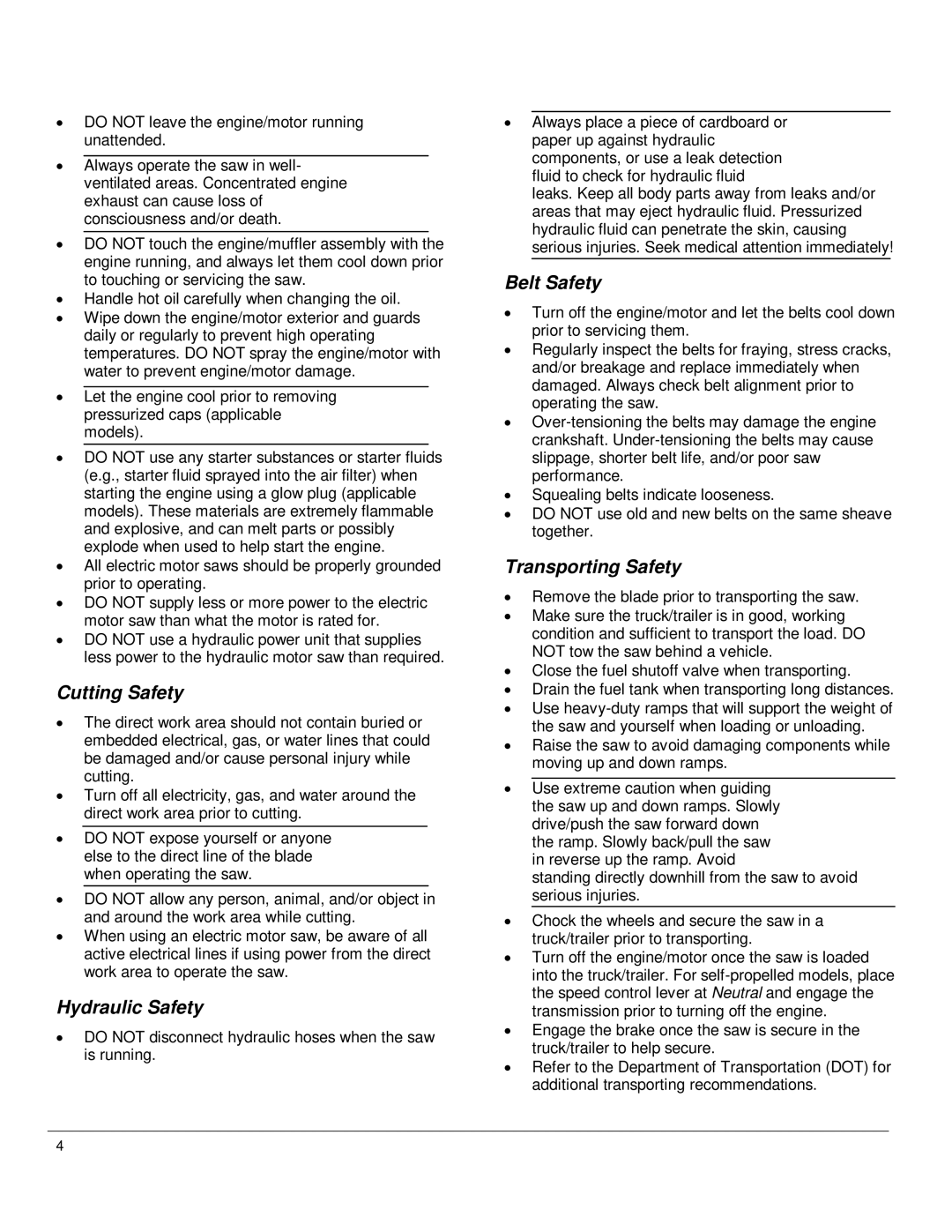
•DO NOT leave the engine/motor running unattended.
•Always operate the saw in well- ventilated areas. Concentrated engine exhaust can cause loss of consciousness and/or death.
•DO NOT touch the engine/muffler assembly with the engine running, and always let them cool down prior to touching or servicing the saw.
•Handle hot oil carefully when changing the oil.
•Wipe down the engine/motor exterior and guards daily or regularly to prevent high operating temperatures. DO NOT spray the engine/motor with water to prevent engine/motor damage.
•Let the engine cool prior to removing pressurized caps (applicable models).
•DO NOT use any starter substances or starter fluids (e.g., starter fluid sprayed into the air filter) when starting the engine using a glow plug (applicable models). These materials are extremely flammable and explosive, and can melt parts or possibly explode when used to help start the engine.
•All electric motor saws should be properly grounded prior to operating.
•DO NOT supply less or more power to the electric motor saw than what the motor is rated for.
•DO NOT use a hydraulic power unit that supplies less power to the hydraulic motor saw than required.
Cutting Safety
•The direct work area should not contain buried or embedded electrical, gas, or water lines that could be damaged and/or cause personal injury while cutting.
•Turn off all electricity, gas, and water around the direct work area prior to cutting.
•DO NOT expose yourself or anyone else to the direct line of the blade when operating the saw.
•DO NOT allow any person, animal, and/or object in and around the work area while cutting.
•When using an electric motor saw, be aware of all active electrical lines if using power from the direct work area to operate the saw.
Hydraulic Safety
•DO NOT disconnect hydraulic hoses when the saw is running.
•Always place a piece of cardboard or paper up against hydraulic components, or use a leak detection fluid to check for hydraulic fluid
leaks. Keep all body parts away from leaks and/or areas that may eject hydraulic fluid. Pressurized hydraulic fluid can penetrate the skin, causing serious injuries. Seek medical attention immediately!
Belt Safety
•Turn off the engine/motor and let the belts cool down prior to servicing them.
•Regularly inspect the belts for fraying, stress cracks, and/or breakage and replace immediately when damaged. Always check belt alignment prior to operating the saw.
•
•Squealing belts indicate looseness.
•DO NOT use old and new belts on the same sheave together.
Transporting Safety
•Remove the blade prior to transporting the saw.
•Make sure the truck/trailer is in good, working condition and sufficient to transport the load. DO NOT tow the saw behind a vehicle.
•Close the fuel shutoff valve when transporting.
•Drain the fuel tank when transporting long distances.
•Use
•Raise the saw to avoid damaging components while moving up and down ramps.
•Use extreme caution when guiding the saw up and down ramps. Slowly drive/push the saw forward down the ramp. Slowly back/pull the saw in reverse up the ramp. Avoid
standing directly downhill from the saw to avoid serious injuries.
•Chock the wheels and secure the saw in a truck/trailer prior to transporting.
•Turn off the engine/motor once the saw is loaded into the truck/trailer. For
•Engage the brake once the saw is secure in the truck/trailer to help secure.
•Refer to the Department of Transportation (DOT) for additional transporting recommendations.
4
